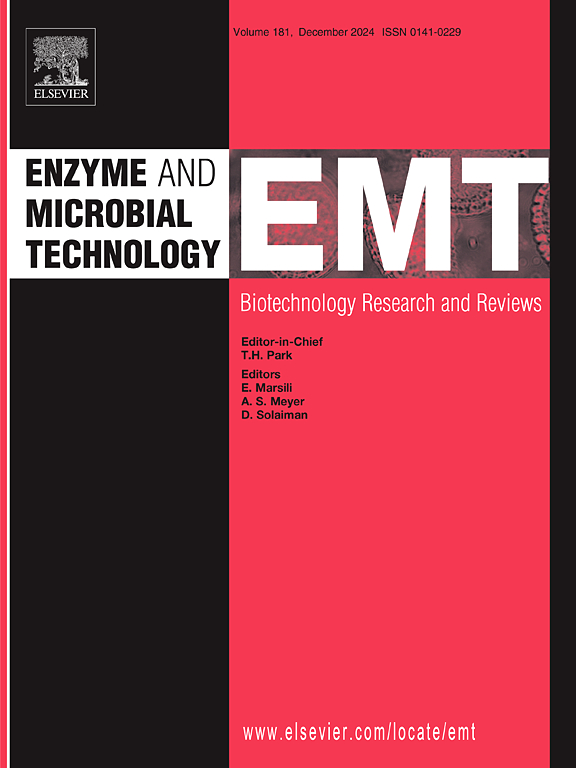CEL3C的功能表征揭示了其在里氏木霉C30中调控纤维素酶基因表达的关键作用
IF 3.7
3区 生物学
Q2 BIOTECHNOLOGY & APPLIED MICROBIOLOGY
引用次数: 0
摘要
里氏木霉核定位的β-葡萄糖苷酶CEL3C在纤维素酶调控中起关键作用,但其机制尚不清楚。为了解决这个问题,我们通过CRISPR-Cas9破坏了高纤维素水解菌株T. reesei Rut C30中的CEL3C,并评估了在富含麦芽糖的MGD诱导下纤维素酶的产量。缺失CEL3C显著提高了总纤维素酶活性31.28 % (p <; 0.05),其中β-葡萄糖苷酶、内切葡聚糖酶和纤维素生物水解酶活性分别提高了94.97 %、19.40 %和28.99 %。这些改善是由核心纤维素酶基因(CEL7A: 2.01倍;CEL6A: 1.5倍;CEL12A: 2.0倍;CEL5A: 1.32倍)和β-葡萄糖苷酶(CEL3A: 6.41倍;CEL3B: 5.02倍),证实转录水平的控制是主要的调控机制。转录组学分析鉴定了688个差异表达基因(399个上调,299个下调),主要变化包括转录激活因子XYR1(59.6 %增加)、ACE3(75.49 %增加)和RXE1(161.56 %增加)的激活,抑制因子RCE1(65.86 %减少)和RCE2(65.23 %减少)的抑制,以及糖转运蛋白(TrireC30_133589: 13.41倍)和ER伴侣(BIP1: 1.26倍;PDI1: 1.55倍)。这些改变共同增强了诱导剂的摄取、酶的成熟和分泌,同时减轻了mapk介导的抑制(TMK2: 110.54 %下降)。细胞内糖谱分析显示,在T. reesei ΔCEL3C中检测不到根二糖和纤维二糖,而葡萄糖和槐糖水平分别增加了31.71 %和13.45 % (p <; 0.05)。这些结果表明,CEL3C缺失增强了β-葡萄糖苷酶介导的双糖水解成葡萄糖,并可能通过转糖基化促进糖的形成。与此同时,双糖转运蛋白的上调可能促进糖的摄取。这两种机制共同促进了槐糖在细胞内的富集,从而增强了纤维素酶基因的诱导和酶的产生。我们的研究结果表明,CEL3C是一种双重功能的核调节剂,通过转录和酶促途径平衡纤维素酶的合成,为优化工业纤维素酶产量的工程T. reesei提供了可操作的靶点。本文章由计算机程序翻译,如有差异,请以英文原文为准。
Functional characterization of CEL3C reveals its critical role in regulating cellulase gene expression in Trichoderma reesei Rut C30
The nuclear-localized β-glucosidase CEL3C in Trichoderma reesei plays a pivotal role in cellulase regulation, though its mechanism remains poorly understood. To address this, we disrupted CEL3C in the hypercellulolytic strain T. reesei Rut C30 via CRISPR-Cas9 and evaluated cellulase production under sophorose-rich MGD induction. Deletion of CEL3C significantly enhanced total cellulase activity by 31.28 % (p < 0.05), with β-glucosidase, endoglucanase, and cellobiohydrolase activities increasing by 94.97 %, 19.40 %, and 28.99 %, respectively. These improvements were driven by transcriptional upregulation of core cellulase genes (CEL7A: 2.01-fold; CEL6A: 1.5-fold; CEL12A: 2.0-fold; CEL5A: 1.32-fold) and β-glucosidases (CEL3A: 6.41-fold; CEL3B: 5.02-fold), confirming transcriptional-level control as the dominant regulatory mechanism. Transcriptomic profiling identified 688 differentially expressed genes (399 upregulated, 299 downregulated), with key changes including activation of transcriptional activators XYR1 (59.6 % increase), ACE3 (75.49 % increase), and RXE1 (161.56 % increase), suppression of repressors RCE1 (65.86 % decrease) and RCE2 (65.23 % decrease), and induction of sugar transporters (TrireC30_133589: 13.41-fold) and ER chaperones (BIP1: 1.26-fold; PDI1: 1.55-fold). These alterations collectively enhanced inducer uptake, enzyme maturation, and secretion while alleviating MAPK-mediated repression (TMK2: 110.54 % decrease). Intracellular sugar profiling revealed that gentiobiose and cellobiose were undetectable in the T. reesei ΔCEL3C, whereas glucose and sophorose levels increased by 31.71 % and 13.45 % (p < 0.05), respectively. These results suggest that CEL3C deletion enhances β-glucosidase-mediated hydrolysis of disaccharides into glucose and possibly promotes sophorose formation via transglycosylation. In parallel, the upregulation of disaccharide transporters may facilitate sophorose uptake. Together, these two mechanisms contributed to the intracellular enrichment of sophorose, thereby amplifying cellulase gene induction and enzyme production. Our findings establish CEL3C as a dual-function nuclear regulator that balances cellulase synthesis through transcriptional and enzymatic pathways, providing actionable targets for engineering T. reesei with optimized industrial cellulase yields.
求助全文
通过发布文献求助,成功后即可免费获取论文全文。
去求助
来源期刊

Enzyme and Microbial Technology
生物-生物工程与应用微生物
CiteScore
7.60
自引率
5.90%
发文量
142
审稿时长
38 days
期刊介绍:
Enzyme and Microbial Technology is an international, peer-reviewed journal publishing original research and reviews, of biotechnological significance and novelty, on basic and applied aspects of the science and technology of processes involving the use of enzymes, micro-organisms, animal cells and plant cells.
We especially encourage submissions on:
Biocatalysis and the use of Directed Evolution in Synthetic Biology and Biotechnology
Biotechnological Production of New Bioactive Molecules, Biomaterials, Biopharmaceuticals, and Biofuels
New Imaging Techniques and Biosensors, especially as applicable to Healthcare and Systems Biology
New Biotechnological Approaches in Genomics, Proteomics and Metabolomics
Metabolic Engineering, Biomolecular Engineering and Nanobiotechnology
Manuscripts which report isolation, purification, immobilization or utilization of organisms or enzymes which are already well-described in the literature are not suitable for publication in EMT, unless their primary purpose is to report significant new findings or approaches which are of broad biotechnological importance. Similarly, manuscripts which report optimization studies on well-established processes are inappropriate. EMT does not accept papers dealing with mathematical modeling unless they report significant, new experimental data.
 求助内容:
求助内容: 应助结果提醒方式:
应助结果提醒方式:


